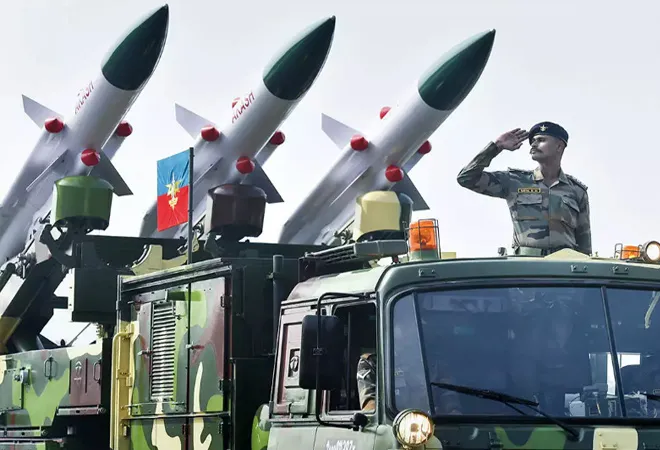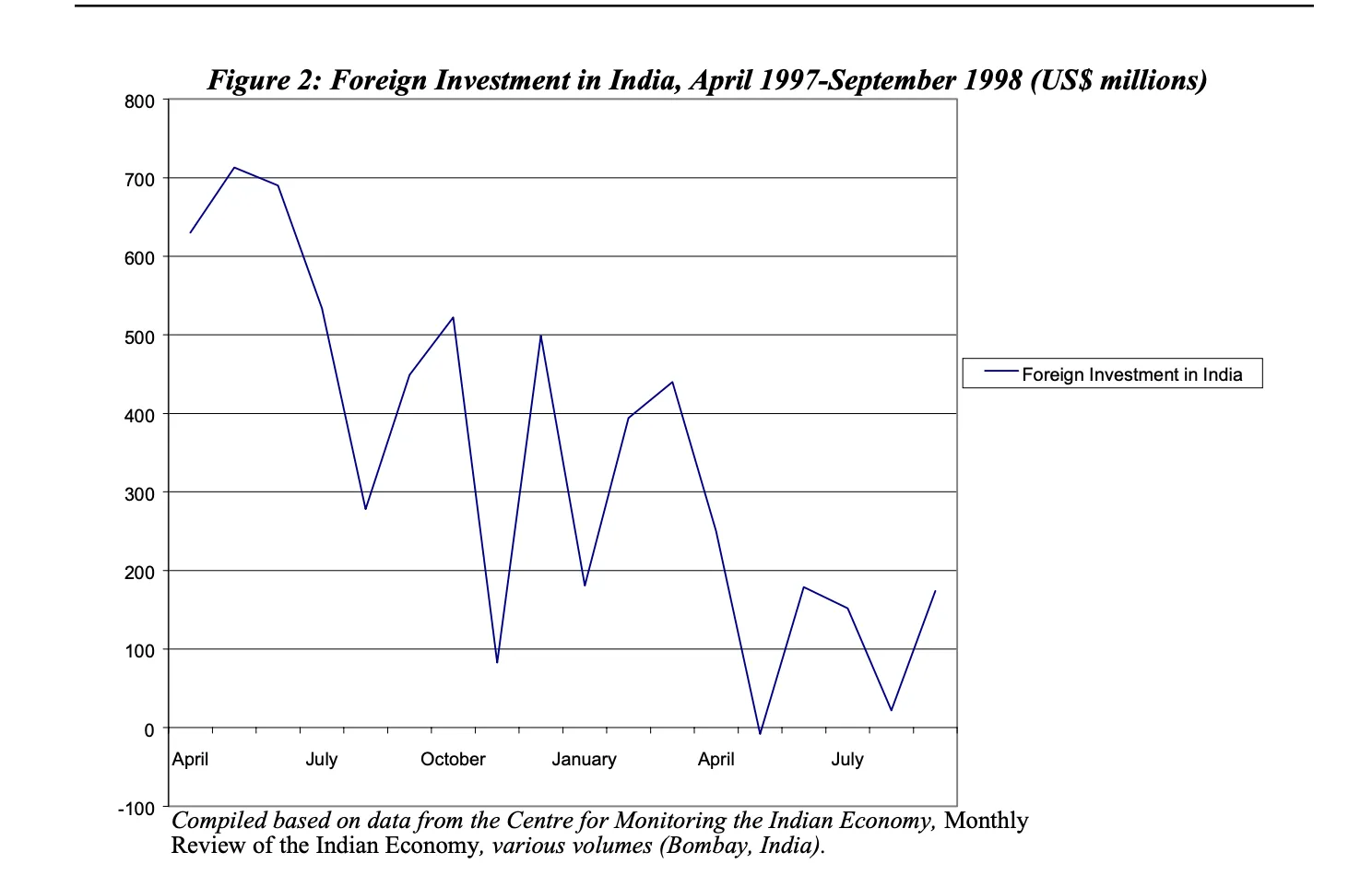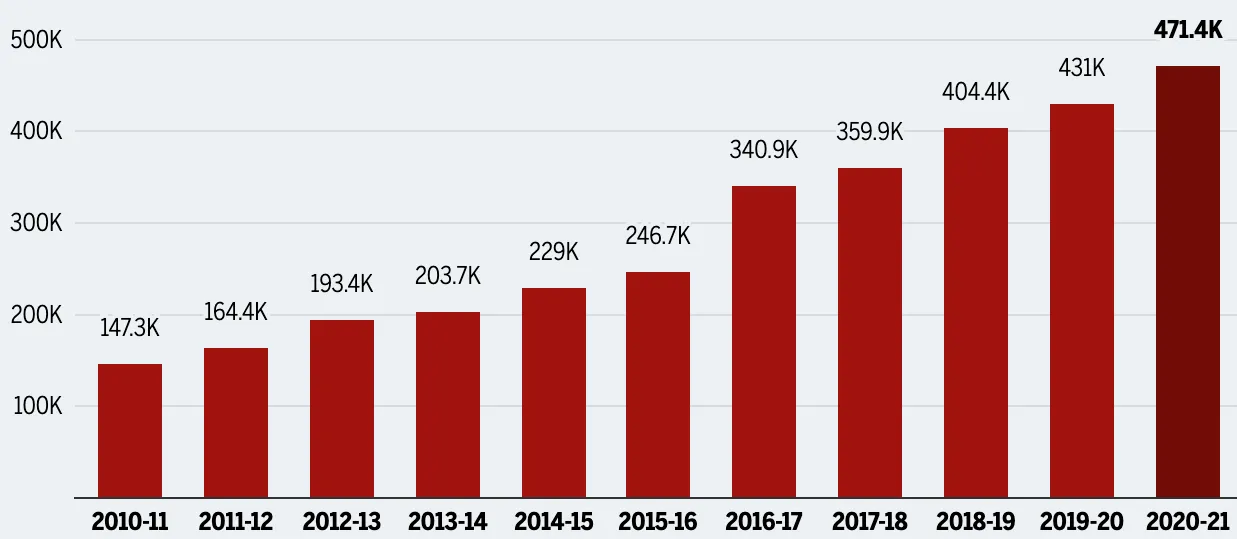-
CENTRES
Progammes & Centres
Location
As India modernises its defence capabilities and becomes self-reliant in defence manufacturing, it will become a key player in the global defence industry

This piece is part of the series, 25 Years Since Pokhran II: Reviewing India’s Nuclear Odyssey
In May 1998, India piloted a series of nuclear tests at the Pokhran test range in Rajasthan, marking a significant milestone in the country's nuclear programme. However, while strategic and security concerns primarily drove India's most coveted 'Operation Shakti' (Pokhran-II), they also had significant economic implications, both in terms of the immediate costs of conducting the tests and the long-term benefits that accrued from them.
Following the nuclear tests, India faced a series of economic sanctions from several countries, including the United States (US), Canada, Japan, Germany and Sweden, among others. These sanctions led to a decline in foreign investments (see figure 1) and a slowdown in the country’s economic growth. As a result, there were significant declines in almost all categories of private flows to India. It remained considerably lower than in 1997, impacting both direct and portfolio investments. Furthermore, receipts from external commercial borrowing also witnessed a marked reduction after May 1998.
Figure 1: Foreign Investment in India, April 1997 - September 1998 (in US$ million)
 Source: Morrow and Carriere (1999); Data from the Centre for Monitoring the Indian Economy (CMIE)
Source: Morrow and Carriere (1999); Data from the Centre for Monitoring the Indian Economy (CMIE)
The sanctions also affected India's access to high technology, as many countries were reluctant to transfer sensitive technology to a nuclear-armed state. The cessation of foreign aid by the US, under the Foreign Assistance Act, resulted in India losing US$51.3 million in aid in 1998. This included US$12 million in aid for economic development and US$9 million for the Housing Guaranty Program. Moreover, US$6 million designated for a greenhouse gas programme and funding for the reproductive health programme were also halted.
India faced a series of economic sanctions from several countries, including the United States (US), Canada, Japan, Germany and Sweden, among others.
Despite the initial setbacks, India was able to mitigate the economic impact of the sanctions through a combination of domestic measures and international diplomacy. The Indian government introduced a series of economic reforms, including liberalisation of foreign investment, reduction of trade barriers, and deregulation of industries. Additionally, India pursued an active foreign policy, reaching out to other countries in the developing world and strengthening ties with major powers like Russia, China, and the European Union.
The nuclear tests directly impacted India's defence industry and technological capabilities. The successful tests of nuclear devices demonstrated India's indigenous technological abilities, boosting the morale of the scientific community, and strengthening the country's defence preparedness. However, the high costs of the nuclear program and the sanctions imposed by other countries led to a strain on the country's finances, which had to be diverted towards the defence sector. Nevertheless, the tests also stimulated India's defence industry, as new technologies and products were developed for the nuclear program. India is now believed to have a stockpile of around 150-200 nuclear warheads, making it one of the world's top nuclear powers. In addition, these technologies and products had spin-off benefits for civilian applications, leading to the development of new industries in the domains of nuclear power, space technology, and high-performance computing.
The Pokhran tests played a significant role in India's pursuit of self-reliance in defence. In 2014, India launched the 'Make in India' initiative, with one of the primary objectives being upgrading its defence capabilities and reducing dependence on foreign technology. As a result, the Indian government has taken several steps to simplify the defence procurement process and reduce the time taken to obtain licenses, making it easier for foreign companies to set up manufacturing units in India. This has created significant opportunities for foreign investment in India's defence industry, leading to technology transfer and increased trade and investment while adding momentum to the defence sector upgradation that the Pokhran tests had started.
The Indian government introduced a series of economic reforms, including liberalisation of foreign investment, reduction of trade barriers, and deregulation of industries.
Under the aegis of 'Make in India', the Indian government has identified the defence and aerospace sector as a priority for the ‘Aatmanirbhar Bharat’ (Self-Reliant India) initiative. This includes establishing an indigenous manufacturing infrastructure and a Research and Development (R&D) ecosystem. India is currently the third largest military spender globally, with a defence budget accounting for 2.15 percent of the country's total GDP – the country’s defence budget has grown at an average rate of 9 percent annually in the last decade (see Figure 2). The government aims to achieve a turnover of US$ 25 billion, including exports of US$ 5 billion in aerospace and defence goods and services by 2025. Additionally, two defence industrial corridors have been established in Uttar Pradesh and Tamil Nadu, and defence exports have surged to an all-time high of approximately US$ 2 billion in FY 2022-23, representing a more than 10-fold increase since 2016-17.
Figure 2: India’s Defence Budget, 2010-11 to 2020-21 (in INR 10 million)
 Source: The Times of India
Source: The Times of India
India's increased defence capabilities have significantly enhanced its economic diplomacy efforts. For instance, India's defence industry has been one of the critical areas of cooperation between India and other countries in the spheres of technology transfer, joint production, and co-development of military equipment. For example, India's partnership with Russia to develop BrahMos supersonic cruise missiles has strengthened India's realm of defence and opened up opportunities for the joint production and export of these missiles to other countries. The India-Russia joint venture is estimated to bag orders worth US$ 5 billion by 2025. Similarly, India's defence partnership with the US has led to joint production and co-development of defence equipment. This has not only helped India to modernise its defence sector but also led to the creation of new businesses and employment opportunities in both countries.
Under the aegis of 'Make in India', the Indian government has identified the defence and aerospace sector as a priority for the ‘Aatmanirbhar Bharat’ (Self-Reliant India) initiative.
India's nuclear competencies have also served as a deterrent against potential adversaries, strengthening the country's national security posture. Moreover, its nuclear weapons program has enhanced India's strategic position, which has helped the nation safeguard its sovereignty and territorial integrity. While the Make in India initiative reflects India's commitment to self-reliance and developing its own technology, aiming to achieve long-term strategic and economic goals; the legacy of the Pokhran tests is a testament to India's determination to become a significant player in the global arena. As India modernises its defence capabilities and becomes self-reliant in defence manufacturing, it will likely attract more foreign investment and become a key player in the global defence industry.
Soumya Bhowmick is an Associate Fellow at the Centre for New Economic Diplomacy, Observer Research Foundation
The views expressed above belong to the author(s). ORF research and analyses now available on Telegram! Click here to access our curated content — blogs, longforms and interviews.

Soumya Bhowmick is a Fellow and Lead, World Economies and Sustainability at the Centre for New Economic Diplomacy (CNED) at Observer Research Foundation (ORF). He ...
Read More +